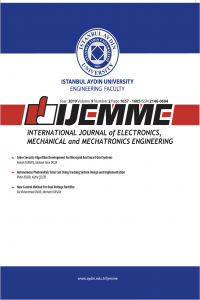FEATURE EXTRACTION BASED WAVELET TRANSFORM IN BREAST CANCER DIAGNOSIS USING FUZZY AND NON-FUZZY CLASSIFICATION
FEATURE EXTRACTION BASED WAVELET TRANSFORM IN BREAST CANCER DIAGNOSIS USING FUZZY AND NON-FUZZY CLASSIFICATION
Breast cancer, Fuzzy subtractive clustering ANFIS, Wavelet transform, Support vector machines,
___
- In-Sung J., Devinder T. and Wang G.N. Neural Network Based Algorithms for diagnosis and classification of breast canser tumor. Department of Industrial and University, South Korea, 2011. Ajou
- Gorgel P. , “Cancer Region diagnosis of 2-dimensional mammographic data using image processing techniques”, İstanbul University, The Institute of Sciences, Computer Engineering Department, PhD thesis, 2011.
- P. Delogu, M. E. Fantacci, P. Kasae, A. mammographic masses using a gradient- based segmentation algorithm and a neural classifier”, Computers in Biology and Medicine, vol. 37, pp. 1479 – 1491, 2007. of
- R. M. Rangayyan, N. R. Mudigonda, J. E. L. Desautels, “Boundary modelling and shape analysis methods for classification of mammographic masses”, Medical and Biological Engineering and Computing, vol. 38, no.5, pp. 487-496, 2000.
- D. Cascio, F. Fauci, R. Magro, G. Raso, “Mammogram segmentation by contour searching and mass lesions classification with neural network ”, IEEE Transactions on Nuclear Science, vol.53, no.5, pp. 2827-2833, 2006.
- D. Tralic, J. Bozek, S. Grgic, "Shape analysis and classification of masses in mammographic images using neural networks", 18th International Conference on Systems, Signals and Image Processing (IWSSIP), Sarajevo, 2011.
- S. Mallat, “A compact multiresolution representation: The wavelet model”, IEEE Computer Society Workshop Washington, 1987. Vision, Processing using MATLAB,
- M. Alata, M. Molhim, “Optimizing of fuzzy C-means clustering Algorithm using GA”, World Academy of Science, Engineering and Technology, vol. 39, 2008.
- A. Elmzabi, M. Bellafkih, M. Ramdani, “An adaptive fuzzy clustering approach for the network management”, World Academy of Science, Engineering and Technology, vol.31, pp. 425-430, 2007.
- P. Tahmasebi, A. Hezarkhani, “Application of Adaptive Neuro- Fuzzy Inference System for Grade Estimation; Case Study”, Australian Journal of Basic and Applied Sciences, vol.4, no.3, pp. 408- 420, 2010.
- V. Vapnik, Statistical Learning Theory, Wiley, New York, 1998
- C.J.C. Burges, A Tutorial on Support Vector Machines for Pattern Recognition, Kluwer Academic Publishers, Dordrecht, 1998.
- G. B. Junior, A. C. Paiva et al., Classification of breast tissues using Moran's index and Geary's coefficient as texture signatures and SVM, Computers in Biology and Medicine, 39 (2009), 1063 -1072.
- J. Yan, B. Zhang, N. Liu et al., Effective and efficient dimensionality reduction for Large-Scale Preprocessing, IEEE Transactions on Knowledge and Data Engineering, 18 (2006), 320-333. Streaming Data
- ISSN: 2146-0604
- Başlangıç: 2011
- Yayıncı: İstanbul Aydın Üniversitesi
APPLICATION OF HIDDEN MARKOV CHAINS IN QUALITY CONTROL
Hanife DEMIRALP, Ehsan MOGHIMIHADJI
TARGET RECOGNITION WITH COLOR COMPONENTS AND SOBEL OPERATOR
Sertan AKARLAR, Mustafa YAGIMLI
COMPUTABILITY OF DESIGN BY MEANS OF ITS COGNITIVE CONTENT
THE EFFECTS OF DIGITALIZATION ON TURKISH CARICATURE
ANTIOXIDANT ACTIVITY OF ETHANOLIC EXTRACT FROM RUMEX CRISTATUS DC
Sibel KAHRAMAN, Refiye YANARDAG
Ayse KOCALMIS BILHAN, Erhan AKBAL
İlkay YELMEN, Nahide TOSYALIOGLU
